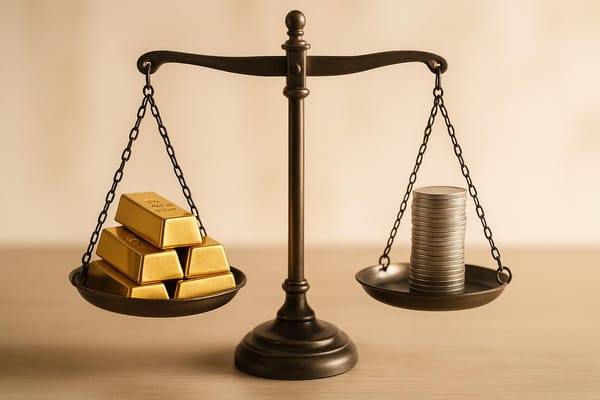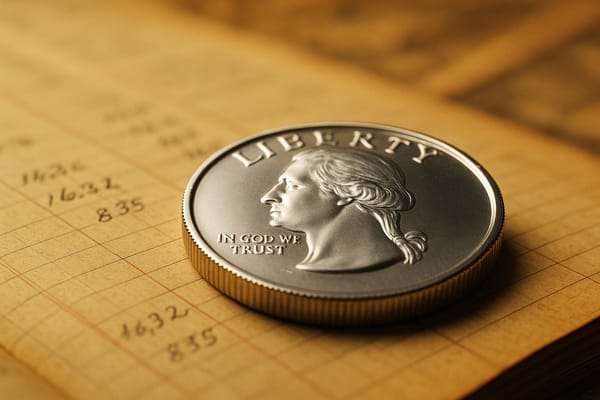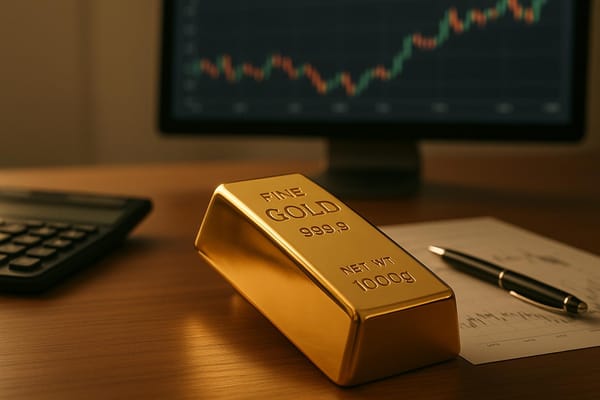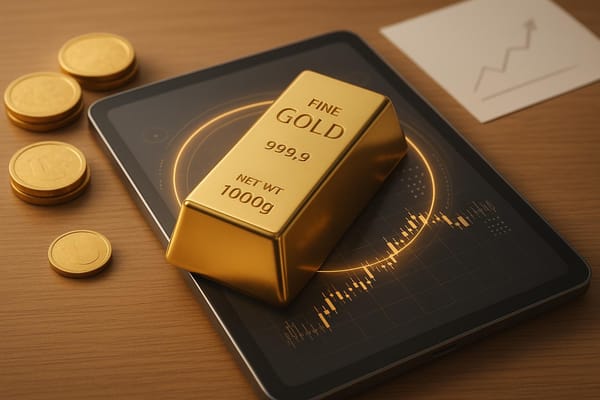How Currency Fluctuations Impact Gold Prices
Explore how U.S. dollar fluctuations affect gold prices, investment strategies, and the complex dynamics of currency and commodity markets.
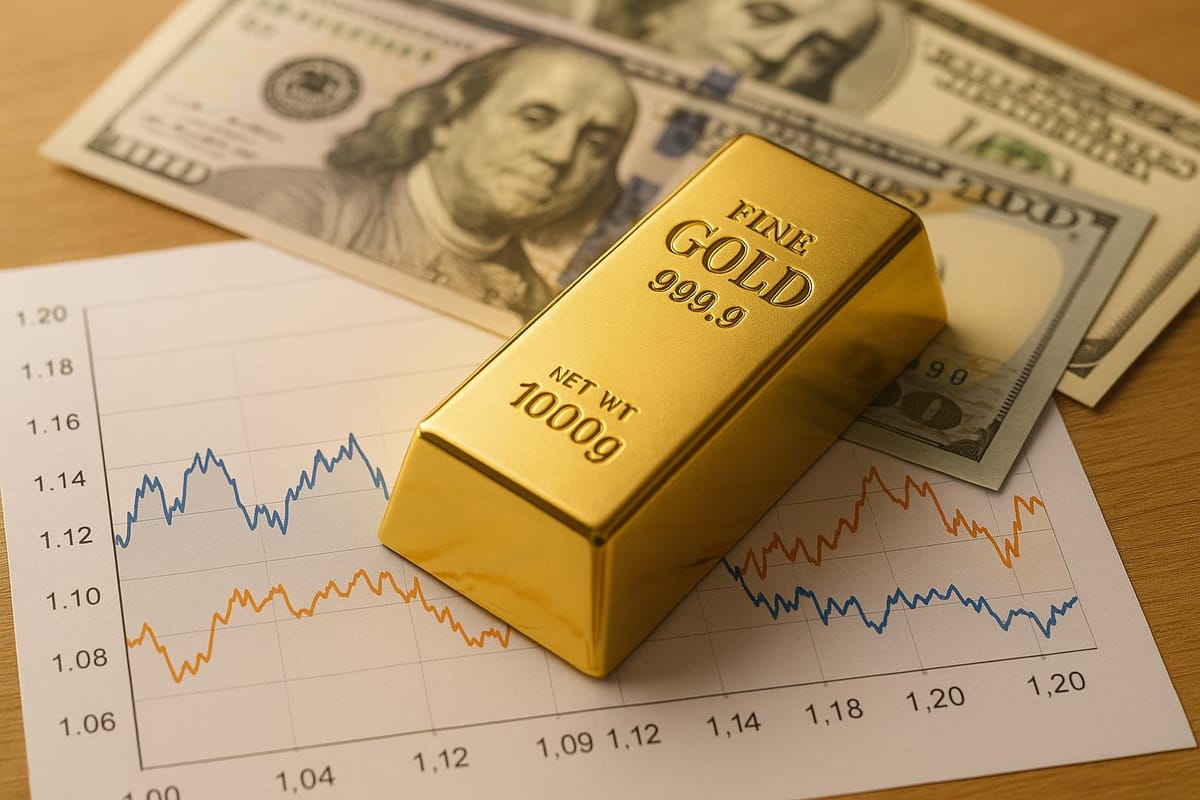
Money moves change how much gold costs. Here's the main point: when the U.S. dollar gets strong, gold prices often go down, and when the dollar gets weak, gold prices tend to go up. This happens because gold is sold in U.S. dollars, so it's either cheap or dear for those who use other money types. But, there are times, like big world trouble or when markets are unsure, when both gold and the dollar might climb side by side.
Key Points:
- Dollar Power vs. Gold: A tough dollar makes fewer people want gold, so its cost goes down. A soft dollar makes more people want gold, so its cost goes up.
- Money Matters: Moves in interest rates by the Federal Reserve hit how strong the dollar is, swaying how people see gold.
- Big World Stuff: Crises, worry of prices going up, or big fights over land can mess up the normal gold-dollar link.
- How People Act: Big banks buying, use of gold in stuff like rings, and betting on prices also shift what gold costs.
Gold stays a top pick to keep money safe, mainly when prices climb or money is shaky. For U.S. folks putting money places, mixing gold with other holds and watching money signs like interest rates and price jumps can help handle risks that come with money moves.
What Is The Relationship Between Gold And The US Dollar? - Learn About Economics
How the U.S. Money Changes Gold Prices
The tie between the U.S. dollar and gold prices is one investors often lean on - though it can have its odd moments. For investors in the U.S., knowing this link helps when they try to handle money risks in their money plans. It also shapes how Americans use gold in their money plans.
Why Gold and the Dollar Often Move in Different Ways
Most of the time, if the dollar gets strong, gold prices fall. But if the dollar gets weak, gold costs more. This back and forth tie is there because gold prices are set in U.S. dollars. A strong dollar means buyers with other money must pay more of their own money to buy gold, making them want less gold, which then makes the price fall.
A strong dollar often shows a healthy U.S. economy. When this happens, investors like things that can grow over gold, which does not give them extra money or pay them back. Also, high-interest rates from the Federal Reserve make other things to put money in more inviting, making gold less liked.
When the dollar gets weak, things swap. Gold is then cheaper for people outside the U.S., raising want for it, while Americans might buy gold to guard against their money losing value.
When the Usual Way Changes
Sometimes gold and the dollar go up together, not following their usual path. This often happens in times of big market worries.
- Money crashes are a clear sample. During the 2008 money crash, both the dollar and gold got more valuable. The dollar got strong as global investors ran to U.S. bonds, seen as the safest choice. At the same time, gold prices went up as people looked for a safe spot from market messes.
- Big global fights can also mix things up. In war or global fights, both might rise. The dollar does well since it's the main world money, while gold goes up as a safe pick against trouble.
- Worries about too much money can push both up. When people fear big drops in money value, they may pick both dollars and gold as safe spots.
More Things That Touch Gold Prices
Outside of big troubles, many other parts can twist the dollar-gold tie.
- Big banks buying is key. When big places like China, Russia, or India buy more gold, it can make prices go up, no matter the dollar's strength.
- How investors act in shaky times can also change the usual way. Some might keep both dollars and gold as ways to stay safe.
- Changes in need and amount can beat money effects. For instance, less gold coming up or more people wanting gold for things like jewelry - in places like India - can make prices rise even when the dollar is strong.
- What people feel and quick buys can make prices pop or drop fast. Big moves by funds or computer-driven plans may quickly shake prices in ways we don't expect.
Knowing these finer points helps investors manage money risks better. While the dollar-gold tie is often sure over a long time, it can still surprise us now and then.
How the Move of Money Changes Gold Costs
Money moves have a big part in setting gold costs, moved by big money rules, bank choices, and gold being both a trade good and a way to keep value. Let's look into how these forces work.
Why Gold Has a Price in U.S. Dollars
Gold is set in U.S. dollars, so its price goes up or down with the dollar's power. When the dollar gets strong, gold costs more for those who use other money, like the euro. This is known as the money change effect. On the other hand, a weak dollar makes gold less costly for buyers from other lands, often upping demand and making prices go up.
Banks have a big say here too. Their choices can make these trends stronger and change how gold is priced around the world.
How Rates and Money Plans Matter
The Federal Reserve's choices on rates hit money moves, which then change gold costs. For example, when the Fed ups rates, the dollar often gets strong. This makes dollar things, like bonds, look better than gold, which gives no income. So, high bond yields can make gold less tempting to buyers.
But, the tale is different when money is easy. When the Fed makes rates low or buys bonds with new money, the dollar tends to get weak. This makes gold more liked, mainly as a way to guard against price rises. These moves can cause big, fast changes in gold costs as traders shift plans based on new money states. In the past ten years, such easy money plans have often gone with rising gold costs, showing worries about the dollar’s worth.
Gold as a Guard Against Money Loss
Gold has long been a shield against losing buying power from money drops or price rises. In lands with money troubles, folks often use gold to keep their wealth safe.
That said, in hard money times, people may sell gold to get cash quick, which can drop prices - even when money problems are still there. While gold is good for holding value when money falls slowly, its part can switch in fast crises.
For U.S. buyers, a weak dollar's hit is less straight since gold costs are in dollars. The gains world buyers get from money changes don't hit as much at home.
Many see gold as a part of a big plan to deal with money risks. Mixed with things like foreign money, world shares, or houses, gold can be a big part of a mix to fight the up and down of moving money.
Investment Strategies: Managing Currency Risk in Gold
Putting money in gold has some tough parts, even more so if you are in the U.S., since the price of gold often moves with the dollar. But, there are clear ways to handle these money risks and use market changes. We'll go deep into how mixing up your money places and keeping a close watch on money trends can keep your earnings safe.
Mix it Up with Different Assets and Money Types
A good way to deal with the risk from money changes is to spread your money wide across various types and money forms. Putting gold together with other ways to invest that react in their own ways to these changes in money value can even out your total mix of investments.
- Plots and houses trusts often do well when prices go up overall, or when the dollar falls, much like gold.
- Stocks from other lands can win when the dollar falls because the money they make changes back into more dollars, which boosts what you earn.
- TIPS (Treasury Inflation-Protected Securities) fight rising prices, adding to what gold does in your mix.
Putting money forms from other places into the mix can add another safe layer. For example, using euros, Swiss francs, or Japanese yen - through bonds from other lands or money type funds - can lessen hurt when the dollar falls. These money types often get strong with gold when this happens.
The key move is to change the mix often. If the dollar gets strong and gold prices fall, think about buying more gold while it costs less. On the other hand, when gold prices go up as the dollar falls, it might be smart to get some money from gold and put it into other things.
Watch Money Signs and Big Bank Moves
Eyeing the moves in money data and what the big banks decide is key to handling money risks in gold buying. What the Federal Reserve does, mainly with interest rates, hits the dollar's power right away and gold's pull. FOMC meeting notes often give hints about rate changes soon, which is big news for buyers.
Some reports also shift how much cash and gold are worth. For instance:
- Reports on jobs outside the farms show job trends that can move money markets.
- The CPI (Consumer Price Index) shows price rise levels, and that often pushes gold prices up.
Another big thing to watch is big bank gold buys. When places like China, Russia, or India get a lot of gold, it often shows they worry about the dollar being steady. These moves can keep gold prices up even when the dollar does well.
Looking at the Dollar Index (DXY) can also give quick views into money trends. Often, when the index gets more than 105, gold feels push to sell. But, when it falls under 95, gold often gets more love from buyers around the world.
To keep track of these points, think about setting up alarms for big money reports and what the Federal Reserve says. Many money sites give out free alerts to help you stay knowing without always having to check.
Use Tools Like Gold and Silver.net

Getting good info is key to understanding how money trends and gold prices link up. Sites like Gold and Silver.net give detailed advice for U.S. folks who handle money risks in metals.
Their weekly articles show how changes in the dollar touch gold prices, while their market analysis looks deep into how the Federal Reserve moves and world money shifts act. You get real tips, not just any advice, to help decide when to buy gold and handle your money in different market times.
For updates right away, their email newsletters tell you about big money or central bank news that might change your gold plans. This keeps you in the know without always having to watch the markets.
If you want to know more, the site's private library gives past data on how old money issues changed gold prices. This info helps you see patterns and make smarter choices when times are tough.
Also, the community of investors on Gold and Silver.net is a place to talk about experiences and ways to deal with money risks. Learning from others in the same boat can give you new ideas and useful tips.
Gold vs. Major Money: A Close Look
Seeing how gold does when compared to big money is key, more so when money markets are not stable. For U.S. people who put money in, this choice is often about keeping cash or moving to gold. By looking at how gold does next to usual money, they can pick better when times are unsure.
Take 2025, for instance. Gold jumped up nearly 50%, while the S&P 500 only went up 15%. This big jump made more people see gold as a safe place, mainly when inflation and doubt ate at the worth of regular money.
The data show it: gold ETFs got a record $64 billion in 2025, and top banks have been buying more than 1,000 tonnes of gold each year since 2022. These moves show a growing trust in gold to keep stable when regular money does not.
When to Pick Gold Over Money
There are times when people tend to pick gold over regular money:
- High inflation: When inflation cuts down buying power, gold stands out as a good shield.
- Economic or political mess: Times of big government or world troubles often make regular money less trusted, turning gold into a safer thing to keep.
- Low interest rates: With small gains on money that earns interest, the cost of having gold - even though it does not make money - matters less.
- Fear of bad times: When there are signs of a hard economy ahead, gold's high demand and ease of use worldwide make it a steady option to guard against money ups and downs.
End Thoughts: How Money Changes Affect Gold
Money ups and downs greatly shape gold prices and the risks of putting money in this valued metal. The tie between the U.S. dollar and gold brings both good and tough things for investors to think about.
Main Points for U.S. Investors
The opposite link between the U.S. dollar and gold shows why it's key to watch major money signs. Things like interest rates, what big banks do, and big money news hit both how strong the dollar is and how much gold is worth.
To deal with these moves, spreading your bets across different types of assets and money is a wise way to handle risks from money changes. Gold, in its own right, has turned into a favored choice in plans as a guard against the unknown. Sites like Gold and Silver.net give insights into the market and tips for investing, helping people make smart choices about adding gold to their plans.
Gold as a Long-Term Money Plan
Looking past quick market changes, gold keeps a lasting charm as a trusty thing to own. In times when regular money faces troubles - like during high price rises or big money troubles - gold often keeps or grows its worth.
For solo investors, the aim of having gold isn't just about nailing the best time in the market. Rather, it's about having a backup when money days get hard. By mixing risk control with spreading out assets, gold stands as a firm base in a long-term money plan. Its wide acceptance and long record of being stable make it a safe pick for keeping wealth as time rolls on.
